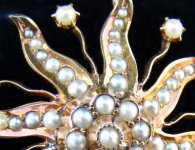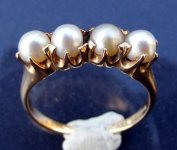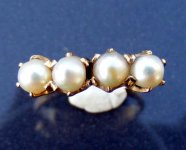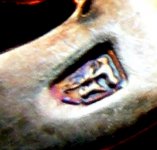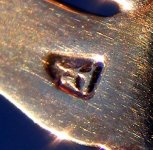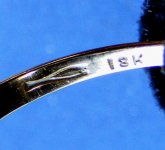J Marcus
Well-known member
- Joined
- Mar 23, 2008
- Messages
- 376
A client of mine has brought in a pendant and a ring that she has inherited. She would like my opinion of them and, after looking at them, I told her that there is some chance that one or both of them were set with natural pearls. I am posting photos of them here along with description and measurements to see what other PG members might have to say about them. I understand, of course, that without certification from a reputable lab no one can be sure, but she has no plans to sell them and doesn't want to go through the certification process.
Item 1: Pendant, yellow gold, marked 14K with a hallmark that appears to be pictorial rather than letters. It is a finely crafted sunburst design, appears to be hand-made. Set with 65 small pearls set variously by bead setting with bright cuts, beaded bezel, and prong settings. The center pearl and the eight immediately surrounding it measure approximately 2.5 mm each. The eight single pearls set singly in prongs around the outside diameter measure 2.6 mm each. The eight wider rays that contain bead-set pearls contain 6 pearls each that taper from 2.4 mm down to 1.2 mm at the tips. The pearls appear to all be slightly to moderately off-round in shape. In color, most of them are a sort of lightly bronzy, very light lavender-grey. The six single pearls prong set around the outside and about three of the bead-set pearls in the tapered rays are more of a light yellow. They are of good to fair luster with no obvious surface flaws showing. The owner states that her mother told her she brought them from England sometime around 1910.
Item 2: ladies ring set with four pearls in prongs. It is marked on the inside with the number "2" near to the top and "18K" and a hallmark resembling a boat paddle or oar. Finely crafted heads are used that appear hand made. The pearls measure 4.1 mm, 4.1 mm, 4.2 mm and 4.1 mm across the horizontal axis. They are all taller than they are wide, having been set with the long axis vertical. The outside two are of a light gold/bronze color--perhaps just a bit of grey, also. The two center ones are more of a light lavendar/grey/ bronze color, one of them having a more lavender cast to it. All of them have a fair to good bronzy luster. There is one small surface flaw down on the side of one of them. Like the pendant described above, the owner states that her mother told me that she brought them from England around 1910.
The pictures were taken with natural light.
I shall anxiously await the expert opinions of my fellow PG participants.
Item 1: Pendant, yellow gold, marked 14K with a hallmark that appears to be pictorial rather than letters. It is a finely crafted sunburst design, appears to be hand-made. Set with 65 small pearls set variously by bead setting with bright cuts, beaded bezel, and prong settings. The center pearl and the eight immediately surrounding it measure approximately 2.5 mm each. The eight single pearls set singly in prongs around the outside diameter measure 2.6 mm each. The eight wider rays that contain bead-set pearls contain 6 pearls each that taper from 2.4 mm down to 1.2 mm at the tips. The pearls appear to all be slightly to moderately off-round in shape. In color, most of them are a sort of lightly bronzy, very light lavender-grey. The six single pearls prong set around the outside and about three of the bead-set pearls in the tapered rays are more of a light yellow. They are of good to fair luster with no obvious surface flaws showing. The owner states that her mother told her she brought them from England sometime around 1910.
Item 2: ladies ring set with four pearls in prongs. It is marked on the inside with the number "2" near to the top and "18K" and a hallmark resembling a boat paddle or oar. Finely crafted heads are used that appear hand made. The pearls measure 4.1 mm, 4.1 mm, 4.2 mm and 4.1 mm across the horizontal axis. They are all taller than they are wide, having been set with the long axis vertical. The outside two are of a light gold/bronze color--perhaps just a bit of grey, also. The two center ones are more of a light lavendar/grey/ bronze color, one of them having a more lavender cast to it. All of them have a fair to good bronzy luster. There is one small surface flaw down on the side of one of them. Like the pendant described above, the owner states that her mother told me that she brought them from England around 1910.
The pictures were taken with natural light.
I shall anxiously await the expert opinions of my fellow PG participants.
Attachments
Last edited:


